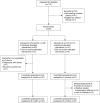Effects of a specially designed aerobic dance routine on mild cognitive impairment
- PMID: 30237705
- PMCID: PMC6138969
- DOI: 10.2147/CIA.S163067
Effects of a specially designed aerobic dance routine on mild cognitive impairment
Abstract
Background: Mild cognitive impairment (MCI) is known as a transitional stage or phase between normal aging and dementia. In addition, it is associated with an increased risk of dementia. Research has shown that moderate-intensity exercise is associated with a decreased risk of cognitive impairment. Two recent studies demonstrated that dance interventions are associated with improved cognitive function in the elderly with MCI.
Purpose: We evaluated the effect of a moderate-intensity aerobic dance routine on the cognitive function in patients with MCI.
Patients and methods: This is a single-blind randomized controlled trial. Sixty MCI patients were randomized to receive either treatment (aerobic dance routine + usual care) or control (usual care only) for 3 months. All patients received usual care for an additional 3 months thereafter. The aerobic dance routine was a specially designed dance routine which involved cognitive effort for patients to memorize the complex movements. Wechsler memory scale-revised logical memory (WMS-R LM) and event-related evoked potentials (ERPs) P300 latency were used to assess patients' cognitive function at baseline, 3 months, and 6 months.
Results: Twenty-nine patients received exercise therapy and 31 patients received usual care. Patients in the treatment group showed a greater improvement in memory (difference in WMS-R LM changes over 3 months 4.6; 95% CI 2.2, 7.0; p<0.001) and processing speed (difference in P300 latency changes over 6 months -20.0; 95% CI=-39.5, -0.4; p<0.05) compared to control.
Conclusion: This dance routine improves cognitive function, especially episodic memory and processing speed, in MCI patients and merits promotion in communities.
Keywords: cognitive function; dance; memory; mild cognitive impairment.
Conflict of interest statement
Disclosure The authors report no conflicts of interest in this work.
Figures
Similar articles
-
Effects of Aerobic Dance on Cognition in Older Adults with Mild Cognitive Impairment: A Systematic Review and Meta-Analysis.J Alzheimers Dis. 2020;74(2):679-690. doi: 10.3233/JAD-190681. J Alzheimers Dis. 2020. PMID: 32083578
-
Effect of 3-Month Aerobic Dance on Hippocampal Volume and Cognition in Elderly People With Amnestic Mild Cognitive Impairment: A Randomized Controlled Trial.Front Aging Neurosci. 2022 Mar 10;14:771413. doi: 10.3389/fnagi.2022.771413. eCollection 2022. Front Aging Neurosci. 2022. PMID: 35360212 Free PMC article.
-
Comparative Cognitive Effects of Choreographed Exercise and Multimodal Physical Therapy in Older Adults with Amnestic Mild Cognitive Impairment: Randomized Clinical Trial.J Alzheimers Dis. 2020;73(2):769-783. doi: 10.3233/JAD-190552. J Alzheimers Dis. 2020. PMID: 31868666 Free PMC article. Clinical Trial.
-
White matter integrity of default mode network after a 3-month aerobic dance program in patients with amnestic mild cognitive impairment: a secondary analysis of a randomized clinical trial.Quant Imaging Med Surg. 2025 Mar 3;15(3):2016-2028. doi: 10.21037/qims-24-1212. Epub 2025 Feb 26. Quant Imaging Med Surg. 2025. PMID: 40160635 Free PMC article.
-
Cognitive benefits of music in aerobic exercise: Evidence from a Bayesian network meta-analysis in adults with mild cognitive impairment.Arch Gerontol Geriatr. 2025 Jul;134:105848. doi: 10.1016/j.archger.2025.105848. Epub 2025 Apr 12. Arch Gerontol Geriatr. 2025. PMID: 40287987 Review.
Cited by
-
Aerobic exercise, an effective prevention and treatment for mild cognitive impairment.Front Aging Neurosci. 2023 Aug 8;15:1194559. doi: 10.3389/fnagi.2023.1194559. eCollection 2023. Front Aging Neurosci. 2023. PMID: 37614470 Free PMC article. Review.
-
Group arts interventions for depression and anxiety among older adults: a systematic review and meta-analysis.Nat Ment Health. 2025;3(3):374-386. doi: 10.1038/s44220-024-00368-1. Epub 2025 Mar 5. Nat Ment Health. 2025. PMID: 40084230 Free PMC article.
-
Exercise effects on neuropsychiatric symptoms and quality of life in mild cognitive impairment: a systematic review and meta-analysis.Front Neurol. 2024 Oct 14;15:1447734. doi: 10.3389/fneur.2024.1447734. eCollection 2024. Front Neurol. 2024. PMID: 39469070 Free PMC article.
-
The effect of aerobic dancing on physical fitness and cognitive function in older adults during the COVID-19 pandemic-a natural experiment.Sports Med Health Sci. 2023 Jul 20;5(3):196-204. doi: 10.1016/j.smhs.2023.07.005. eCollection 2023 Sep. Sports Med Health Sci. 2023. PMID: 37753419 Free PMC article.
-
The effectiveness of dance movement interventions for older adults with mild cognitive impairment, Alzheimer's disease, and dementia: A systematic scoping review and meta-analysis.Ageing Res Rev. 2023 Dec;92:102120. doi: 10.1016/j.arr.2023.102120. Epub 2023 Nov 8. Ageing Res Rev. 2023. PMID: 37944706 Free PMC article.
References
-
- Petersen RC, Smith GE, Waring SC, Ivnik RJ, Tangalos EG, Kokmen E. Mild cognitive impairment: clinical characterization and outcome. Arch Neurol. 1999;56(3):303–308. - PubMed
-
- Winblad B, Palmer K, Kivipelto M, et al. Mild cognitive impairment – beyond controversies, towards a consensus: report of the International Working Group on Mild Cognitive Impairment. J Intern Med. 2004;256(3):240–246. - PubMed
-
- Albert MS, DeKosky ST, Dickson D, et al. The diagnosis of mild cognitive impairment due to Alzheimer’s disease: recommendations from the National Institute on Aging-Alzheimer’s Association workgroups on diagnostic guidelines for Alzheimer’s disease. Alzheimers Dement. 2011;7(3):270–279. - PMC - PubMed
Publication types
MeSH terms
LinkOut - more resources
Full Text Sources
Other Literature Sources
Medical
Miscellaneous


